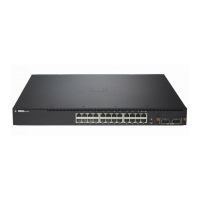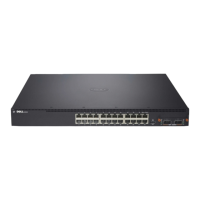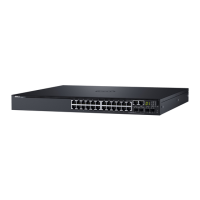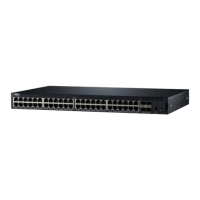System Firmware Version 5.1.0.1 Page 17
Spanning Tree Changes
Administrators may assign more than 1024 VLANs to MSTP instances. Only VLANs that are configured on the
switch will forward traffic.
The PowerConnect switches implements the 802.1Q-2005 standard which builds on 802.1D-2004. 802.1D-2004
incorporates the 802.1t, 802.1w and 802.1s revisions. Port path costs are calculated based on the interface speed as
shown below and are dynamically recalculated on interface activation and link speed changes.
External Port Path Cost values (Port Path Cost in 17.14 of 802.1D-2004) are applicable in STP, RSTP, and MST modes
(Ref. Table 17-3 802.1D-2004). Use the spanning-tree cost command in interface mode to set the external port path
cost.
Link Speed
Default Value
10 Gb/s 2000
1 Gb/s 20000
100 Mb/s 200000
10 Mb/s 2000000
1 Mb/s 20000000
Internal Port Path Cost values are specific to MST mode only (Ref. Table 13-3 802.1Q-2005). Use the spanning-tree
mst <instance> cost command in interface mode to set the internal port path cost.
Link Speed
Default Value
10 Gb/s 2000
1 Gb/s 20000
100 Mb/s 200000
10 Mb/s 2000000
1 Mb/s 20000000
User Configurable CLI Banners
Administrators may configure banners for the following: MOTD, login, and exec. The banners may consist of multiple
lines of text. Each new line will consume an extra two characters (CR/LF) that count against the maximum length
banner that can be configured.
Captive Portal
Captive portal has been extended to support user logout and localization.
802.1Q
The following changes have been made to the operation of VLANs.
VLAN Membership:
By default, trunk ports participate in all VLANs. VLANs created after a trunk port is created are added to all trunk
ports. VLANs deleted are removed from all trunk ports. The operator may configure a trunk port to explicitly disallow
certain VLANs.
Native VLAN Configuration on Trunk Ports:
It is now possible to configure the native VLAN on a port in trunk mode. Trunk mode ports will accept untagged
frames but will always transmit tagged frames. It is also possible to configure a trunk port to drop untagged frames by
filtering on the native VLAN, e.g. by using the switchport trunk allowed vlan remove command.
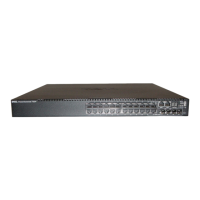
